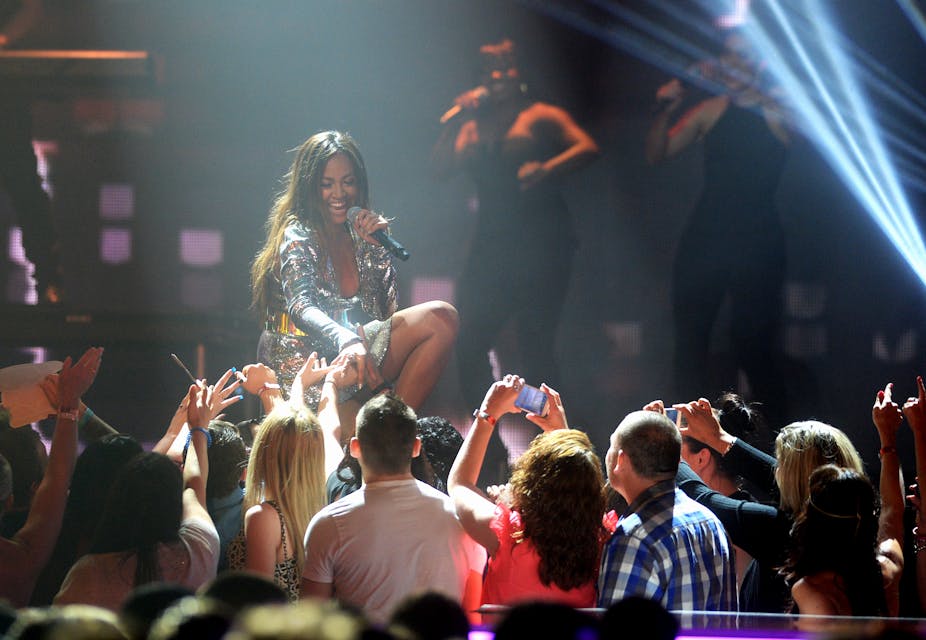After weeks of hyped-up national pride, the halting speeches are over and the awkward presentations made. The 27th Australia Recording Industry Association Awards (the ARIAs) have passed away, marooned way out on the farthest reaches of the digital television dial.
There appears to be a lingering suspicion that the ARIAs exist to give out awards in recognition and validation of artistic achievement. They don’t. They exist to only recognise and validate themselves. They mark the commercial achievements of an industry, not the aesthetic accomplishments of musicians.
For some, that amounts to more or less the same thing. To many of us, however, here will always be something a bit off about a process where the the industry that creates a piece of art is also in charge of judging its excellence.

This puts the ARIA Awards in an untenable position. They are expected to both construct and capture “the moment.” They are meant to produce a spectacular pause in the frenzied proceedings of popular culture and tell us what counts.
But the ARIAs can never live up to the task. It’s too big a job. The ARIAs are meant to sum up all things musical by looking both backwards and forwards at the same time. They have to codify the constant whirring of the mass of inventive dynamism that makes so much music possible. That’s a lot to ask of what is, in effect, an unusually emotive industrial trade show.
The canon ball
The problem lies in the apparent paradox that is the canonisation of the popular – that is, deciding which bits of the flotsam and jetsam of pop culture deserve a spot in the Australian music canon as works of great and timeless art.
For about a century, the values and ideals of high art have increasingly permeated popular music. Our aesthetic sensibilities are routinely enticed with familiar myths that go back at least as far as the early 19th century: the great artist, a transcendental moment, timeless beauty.
All are so firmly incorporated into the way we all talk about popular music that we barely notice them. This is true not only in the painfully obvious cases, such as classic rock or prog rock. These myths pervade almost all popular music cultures.
This process of deciding which forms of pop music are superior to the rest seems endless. Think of the breathless superlatives of award shows, the proliferation of music biopics, documentaries about this or that “greatest album of all time”, and the growing lists of the songs/albums/bands-you-must-hear-before-you-die.
There’s something a bit suspicious about the process of pop music canonisation. It shaves off the sharp edges, smoothing out of all the untidy wrinkles and cumbersome complexity of real musical practice and experience.

It is not coincidental that the Australia Recording Industry Association’s slogan is “United By Music”. However, this strange gathering of those that refer to themselves in the third person collective as “the music industry” is more like a flash mob of industry insiders and strivers than a genuine coming together in celebration of music.
The ARIAs amount to the manufacture of our consent through procedures that “the music industry” itself controls and administers.
Emotional buttons
Music is particularly good at this sort of thing, given its capacity to stir our emotions.
For example, regardless of what you might think of John Farnham, it seems clear that his performance of his hit song “The Voice” at the 2003 ARIA Awards was engineered to place a massive slab of sentimental “Aussie pride” on the viewer’s shoulders. It makes it tough to deride this calculated schmaltz without appearing cynically “un-Australian,” especially when it comes from officially-minted heritage figures such as Farnesy.
Or take the performance of “Funky Tonight” by folksters The John Butler Trio, with the unlikely addition of country rocker Keith Urban on rhythm and solo guitar, from the 2007 ARIAs. It is hard to see Urban and Butler making this shotgun marriage work. And yet they undoubtedly do in this engaging performance, at least until the guitar solos overstay their tenuous welcome at about the four-minute mark or so.
When the ARIAs do allow criticism, it’s directed at the easiest of easy targets. This was made painfully obvious at the 2005 show through comedian Chris Lilley’s satirical reenactment of his cross-dressing school girl character Ja’mie King’s excessive fandom.
Lilley’s shots at that perennial figure of derision, the excessively interested teenage girl, went over just fine with an industry audience that surely knew it was dependent on exactly the kind of enthusiasm Lilley was lampooning.
The 2013 ARIA Awards hit all the marks they had to, bringing us the patriotism of a loyal industry, the heritage of the old brigade, and the excitement of the new stars of now.
They put everyone on one stage and told us repeatedly how uniformly great they all were. Whether it was the latest electro manchild like Sydney producer Flume or the hoariest of old men like Aussie soft rockers Air Supply, the ARIAs must incorporate them all into one spuriously constructed snapshot of “a moment” in Australian music history.
If you think it all feels a bit false, that’s because of what the ARIAs have to be: an attempt by an industry to tell us that the most important bits about our culture just happen to be the bits that they produce and sell.

